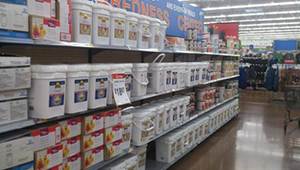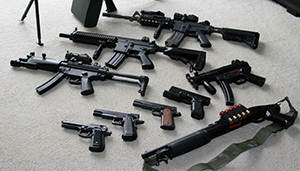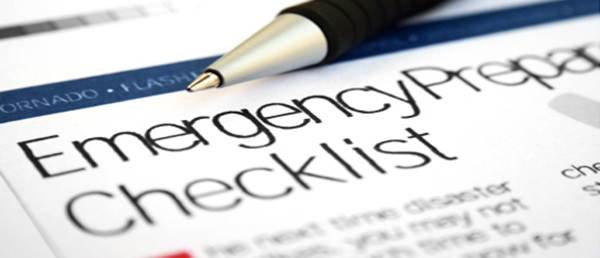Looking at the state of the world, being prepared is more important than ever. Terrorism is on the rise around the globe. Rogue states like North Korea become more dangerous as their stability fails – and North Korea has nuclear weapons. The USA’s neglected power grid is vulnerable to a solar flare that could wipe out electricity across most of the country for a decade. The climate’s changing – calm down, Al Gore, it’s been changing constantly for 4.5 billion years – and that could lead to major storms or even larger scale disasters. Imagine the chaos if a freak wet spring devastated the US wheat crop. That’s a real risk; it’s happening in France right now – but France can replace its crop with imports. We can’t.
Danger and instability surround us, and not being prepared for the worst seems frankly weird. Unfortunately, there’s a lot of flimsy prep advice floating around on the internet. It’s enthusiastic, but shallow.
Here are some more in-depth suggestions on how to start preparing.
#5 Sort the basics first
Most to-do lists seem to start with “Go to WalMart and buy a truckload of rice.” It’s not very obvious why. What are you going to do with it when you get it home? The first thing you need to do is prepare to be prepared. Identify a food storage area – somewhere that’s secure, sheltered, dry and cool. Some people like to keep food in a basement or dugout, which is good for hiding it but makes storage more challenging. Make sure your store is protected against rodents. Set up a storage system in there – strong shelves are ideal. Keeping your food store organized is vital: You’ll need to rotate supplies, using up older items and replacing them. The more organized you keep things the less waste you’ll have and the more prepared you’ll be.
Related: 10 Foods Not to Store
#4 Go to Walmart and buy a truckload of rice
 Now that you’ve sorted out a proper food store you can start stocking it. When it comes to storage life and bulk, dry goods are supreme. You can store a few weeks’ worth of canned or packet foods, but with dry goods you can easily be self-sufficient for months or even years. Start your food reserve with 20 pounds of rice (white lasts longer in storage) and 20 pounds of dried beans. Between them those two will give you a solid reserve of carbohydrates and protein, and you can use them as a base for a whole range of recipes supplemented with seasonings, canned or dried ingredients, and food you’ve harvested from nature.
Now that you’ve sorted out a proper food store you can start stocking it. When it comes to storage life and bulk, dry goods are supreme. You can store a few weeks’ worth of canned or packet foods, but with dry goods you can easily be self-sufficient for months or even years. Start your food reserve with 20 pounds of rice (white lasts longer in storage) and 20 pounds of dried beans. Between them those two will give you a solid reserve of carbohydrates and protein, and you can use them as a base for a whole range of recipes supplemented with seasonings, canned or dried ingredients, and food you’ve harvested from nature.
The next things to add are powdered milk, rolled oats and cooking oil. Add some bulk herbs and spices – in an emergency you can use what’s already in the kitchen, but it’s good to have a proper reserve too. Don’t forget the most important seasoning – salt. Get at least five pounds of that. As you move forward you can add pasta, dried vegetables (this is a great excuse to get a dehydrator and vacuum sealer) and of course more rice and beans.
Related: Survival Food – 59 Long-Term Survival Foods and Supplies at the Grocery Store
#3 Don’t forget the water
If law and order break down you can forget about relying on the water from your faucets. It might keep flowing for a while, but are you going to trust it for drinking and cooking? You have no idea if it’s still being properly treated, and terrorists or lunatics could even deliberately contaminate it. Aim to be as self-sufficient as possible.
The bare minimum is to keep a supply of drinkable water in containers. For survival situations the recommendation is a gallon per person per day, and once you allow for food and washing that’s not a generous amount. Get some five gallon containers – at least four – and keep them filled. Empty and refill them regularly.
Next, look at ways to become more self-sufficient in water. If you already have a well you’re sorted. Otherwise consider a rainwater catchment system. If you have a stream or river nearby you could build a large water filter and run a pipe to it from the stream, giving you a constant filtered supply. Be adaptable, but find something – without water, your refuge is unsustainable.
Related: Storing Water for When Disaster Happens
#2 Sort out your toolkit
Most of us have some sort of toolkit around the house, but if you want to be prepared you need to make sure it’s ready for anything. At a minimum you’ll need a good carpenter’s hammer, a heavier ball peen hammer, wood saw and hacksaw. Other essentials include a monkey wrench, measuring tape, square and level. Cordless drills are great, but a hand drill is also good to have – what if your generator goes and you need to fabricate a replacement part? A set of good screwdrivers is also vital – don’t rely on an electric one. Make sure you have wrenches to fit all bolts on your vehicles and equipment, too.
As well as tools, stock up on basic supplies. Some plumbing fittings are good to have – pipes, joints and similar items. A couple of spools of electrical cable can be used for repairs or projects, and you can also strip and separate the cores if you need fine wire. Simple light fittings, switches and other components help too. Stock up on timber; 4×2 and plywood have a multitude of uses.
This might seem obvious, but a lot of preppers neglect their tools. They aren’t as exciting as guns, but the chances are in a long-term disaster scenario you’ll use them a lot more often.
Related: Tools The Early Pioneers Used on A Daily Basis
#1 Think defense
 Guns are important too, though. You’ll need to be able to hunt, perhaps control predators, and in the worst-case scenario defend your property, stores and lives against looters or desperate refugees. That means having weapons you can count on, and the supplies to keep them running.
Guns are important too, though. You’ll need to be able to hunt, perhaps control predators, and in the worst-case scenario defend your property, stores and lives against looters or desperate refugees. That means having weapons you can count on, and the supplies to keep them running.
There’s no real point in having lots of guns – and if they’re in different calibers they become an actual liability. Get the guns you need, then if you’re tempted to buy another, spend the money on ammunition or reloading components instead. A gun can be maintained and repaired; once ammunition’s been fired, it’s gone. Reloading is a great idea and can stretch your supplies but even then your reserves or propellant, bullets and primers won’t last forever. You need to start with a lot of ammo.
If you can only afford one gun, get a 12-gauge pump action. The Remington 870 is always a popular choice – militaries around the world value its reliability. A shotgun is the most versatile gun you can own, because it can take a wide variety of game as well as being an awesome home defense weapon. For preparedness it’s far superior to a small-caliber rifle like an AR15.
Your second gun should be a good hunting rifle. Bolt or semiauto is fine, and the ideal caliber is .308. Ammo is cheap and widely available because you can use 7.62mm NATO as well. It also has enough punch to take down just about any game. A handgun is a lower priority, but handy to have. Go for a high-capacity 9mm semi, if you’re buying one. Again the ammo is NATO standard and easy to find.
Related: Best Gun for Home Defense
Magazines are a weak point in any gun that uses them. They can get lost or damaged, and springs eventually weaken. This is one advantage of pump shotguns and bolt action rifles – they’re not as dependent on magazines as semiautos. Get as many good quality magazines as you can for any guns that need them, and take good care of them. Then get some weapon spares. Firing pins, springs and backup sights are all good things to have. A chipped firing pin will turn any weapon into junk – you need to have the parts, tools and skills to replace it.
Then focus on building up ammunition supplies. After a major collapse ammo will be more valuable than gold, and it’s generally not something you want to run short of. For the shotgun get a range of shells, from bird shot to rifled slug. In rifle and handgun calibers quantity is the most important factor; cheap military surplus beats premium ammo simply because you can buy more of it. The target effect difference between cheap and fancy ammo is incremental, but an extra round is an extra round.
You may also like:
 Best Fuels For Off-Grid Survival
Best Fuels For Off-Grid Survival
If You Are to Weak to Prep then You Need to Watch This (Video)
24 Movies That Will Teach You a Lot About Survival















The hardest thing to do is to actually get started. An easy way to begin is to go to home depot or Lowe’s and get a supply of 5 gallon plastic containers and a magic marker. Then, when you can go to the store and buy the rice, beans salt and other staples, you have a place to store them that is water, bug and rodent proof. Also look for some oxygen eliminated packets to put in the bottom of these containers. Also good for storing ammo. Use magic marker to label all containers.
yes, the oxygen absorbers are vital..a cheaper version is the hand warmers found at walmart…exact same but different intended purpose…they warm up until the oxygen is used up then they cool down…
Also a good idea, for a little over $100 you can get mylar bags and a sealer with oxygen absorbers. Great for sto ring just about anything you can fit in the bags. Even electronics are more protected in an oxygen free foil wrapped environment.
This is an amazing, concise article that I found very helpful. Thank you.
As to handguns, scrap the 9mm as primary, and instead invest in a high quality .357 Magnum with a minimum 4″ barrel. You then will be able to shoot anything from a .38 shotshell to a full-house deer/bear/badguy load. MUCH more versatile than a 9mm, and .38/357 ammo is available ANYWHERE; plus it is easier to reload for.
Second choice would be a high quality .22. Semiauto or revolver is your choice, but make sure is had at least a 4″ barrel’ preferably 5 or 6″.
In addition, a 148 gr. wadcutter in .38 sp. will take small game without too much meat damage and without too much noise.
Good suggestion re handguns, TSgt B
For defense, I think, this is what I did, I actually went out and am learning a martial art. They can take your guns, knives, etc., but they can not take what you know and whats inside your head. If you do not know how to defend yourself properly: you’re toast! Learn a martial art!
@Cycloneous: Learning any martial arts skill takes years. Too many dojos promote people in order to keep them coming back. Elvis Presley was supposed to hold black belt ratings in several different martial arts. I strongly suspect that if he were to engage in a match with even a first class brown belt in any of those disciplines he would have gotten his butt royally kicked.
I watched a man get promoted to black belt in my grandson’s dojo. He was pitiful. My son and I both agreed thet we hoped he never stood up when someone said, “Shut up.” because he was going to get seriously hurt. It was a mercy promotion done to keep him coming back. He had been going for two years but he still had so many bad faults that he should have still had his beginner’s white belt.
Then there the question of size. In1962 Anton Geesinck took the judo world by storm at the Kodokan in Tokyo. He won the world championship. The first non-Japanese to do so. He was a giant. The old timers said, “If your spirit had been strong, you would have won. The Japanese judoka who lost to him said, “B.S. if you had been out on the floor with that monster you wouldn’t be saying that.”
Up until that time there had been no weight categories. As a result of his stunning victory, weight categories were instituted world wide in judo. Unless you are a highly advanced black belt, advanced in inter-club competitions to the seventh or eight degree the first guy who comes along who outweighs you by probably 50 or more pounds is going to stomp you. Anyone who has had experience in street brawls is going to stomp you. There is a reason why people say, “God didn’t create all men equal, Samuel Colt did.”
My advice: take the money you are spending on karate or whatever classes and buy a decent gun and take shooting lessons. After you have done that, then resume your martial arts classes if you want. They are good exercise.
Has anyone considered that with out fuel or just cooking over a fire, that cooking them things like dried beans (they take a couple of hours to cook on a stove), or rice ( 20 minutes). Unless you do a lot of cooking with un even fire, you will either burn the food or under cook it. Wouldn’t processed foods or dehydrated foods be better. Less cooking . When listing what to stock up on, don’t list dried beans and rice as a staple or you will have a lot of people having to eat raw rice and beans. Thanks for listening. Ioma
I have been storing firewood. I also have two camp stoves, a single burner and a double burner. When things first fall out, my intention is to use the wood in one or more rocket stoves to heat water. Hot water will be a necessity for sanitation, utensil washing and general hygiene. The camp stoves will be used for cooking. That will continue until the fuel is exhausted. By that time I hope to have gained enough experience that I will be able to modulate the wood burning rockets stoves so that cooking on them will not be that much of a problem. I also plan to use wood burning to distill water as I anticipate that we will need to use ocean water for our water supply unless we just happen to have a wet year such as we are experiencing this year. If it were last year, we definitely would be distilling ocean water. Ocean water doesn’t have to be distilled for washing utensils, hands and clothing. It must be boiled however because there will be all sorts of stuff floating in the ocean that you wouldn’t want to touch let along wash with. Drinking water and water for face washing and teeth brushing will have to be distilled as one cannot drink salt water. I would recommend dehydrated foods for getting used to outdoor cooking, but for long term food you are going to need beans and rice. You can store a lot of calories in a small space for a long time with those two items. Beans and rice together release the protein in the beans to supplement the meat you eat. I always wondered why Mexican food featured beans and rice at the same meal. I thought it was overkill on carbs. Then I found out that the rice released the protein in the beans which otherwise was locked and unavailable.